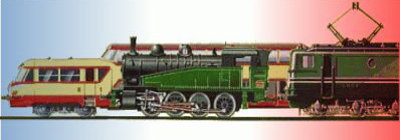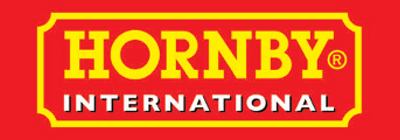(2002-2004)

 - Jouef compagny history
- Jouef compagny history
The firm Le Jouet Français
was created in 1944 by Georges Huard who manufactured plastic kitchen utensils. It also exists some penny toys which includes cars, boats and playsets of horses.
Before 1949, a first railcar, the famous Transsaharian Algiers-Tombouctou
appeared, made with lithographed sheet metal. The very first models were fitted with a rubber band as engine. The reduction scale was HO (ratio of reduction 1/87th), whereas the majority of the other model trains makers produced mainly on the O scale (ratio of reduction 1/43th).
About 1950, Le Jouet Français
or JF
becomes Jouef
.
Since 1952, a complete range is proposed including tracks made of lithographed sheet metal (red then then gray), two passenger coaches with two axles (1ᵗ class in red, 2ᵈ class in blue) also made of lithographed sheet metal, and a clockwork steam locomotive Diabolic
evoking the careening locomotives of pre-2nd world war period. The transsaharian railcar is now fitted with the same clockwork mechanism used in the Diabolic
steam locomotive.
Next year, appear the first passenger coaches with bogies, a 1ᵗ class model and a 2ᵈ class model pointing out the compemporary DEV cars of SNCF, and a Pullman car.
1954 is the start year for plastic injected models which allows low cost production of goods cars (a dropside wagon,
an open goods wagon, a tank wagon and a covered wagon).
1955 is a milestone in the Jouef history: it is the kick-off of Jouef electric model trains, with the first
electric locomotive, the BoBo 9003 SNCF HO scale model which was replaced very quickly by the BoBo 9004 SNCF after the full scale locomotive beat the world speed record on rails (331 km/h on March 29th, 1955). These models were fitted with
one bogie motorized with the famous and bulky motor saucisson
(= large sausage
. French nickname given for the shape of the engine). The power supply system (6 volts) used a battery generator hidden in a signal box or a transformer. The
tracks was made with two brass rails fixed on plastic ballast. The lip of the Sud-Express
electric train set was illustred by René Letourneur, and then electric model trains became popular in France with this trainset Sud-Express
.
Another important change in 1956, the tank-engine 0-4-0 n°708, first issued in clockwork version, started its long career of more than 40 years. More 2 millions models were manufactured.
With the years, Jouef model trains become increasingly accurate, with the strict respect of the scale but the
quality of operation of models is not always present. In addition of the electric model trains, Jouef also
manufacture racing circuits.
After having changed its owner in 1972, the Jouef company become integrated with Le Jouet Français
group which includes also Delacoste
(manufacturer of balloons and toys for first age), Solido
(specialist in the miniature cars), and Heller
(plastic models). This group went into liquidation in
1980 and rule of Court in May 1981.
The different companies of the group Le Jouet Français
are repurchased by various participants in the toy
industry: Majorette
buys Solido
, Vullierme
buys Delacoste
,
Borden
buys Heller
. Then remains Jouef
which is then purchased by a subsidiary
compagny of the CEJI
group (French acronym of Compagnie Générale du Jouet
). This subsidiary compagny named Joustra
(French acronym of Jouet de Strasbourg
) manufactures primarily radio-controlled toys, and the Jouef company is
integrated within the CEJI group. At this time, Jouef adds an activity of import goods by marketing in France, white metal kits from the English brand Keyser
. The white metal kits range includes French rolling stock models like the VH Renaultrailcar, several steam locomotives (2-8-2 TC, 4-6-0 G Paris-Orleans,...), and electric locomotives (BoBo 1200 Paris-Orleans, BoBo 16500 SNCF, 2D2 5500 SNCF). The last two models (electric locomotives BoBo 16500 SNCF and 2D2 5500 SNCF) had a white metal body and used a Jouef motorized frame. The bad reputation of these white metal kits in France, made that sales were stopped in March 1984.
In early 1980, competition against video and electronic toys is hard, also the scale models market is speed loss.
The CEJI
group collapsed for bankruptcy in 1986. The Jouef
activity is recovered by independent
contractors including Jacques Barret, and then starts in a new policy of diversification for activities (miniature cars on the 1/43th and 1/18th scale, radiocontrolled cars) and a very agressive marketing with many links with other partners (Bachmann,
Lilliput, Rivarossi, Ibertren, Lima). But it also collapsed one more time for bankruptcy in late 1995. The Jouef
compagny is bought on 1996 by the Italian Rivarossi and is integrated in its group which also includes others
model railway makers (Lima bought in 1992, Arnold bought in 1995, and Rivarossi). The production of Jouef models was still done in France. In the meantime, the Rivarossi Group (which includes Rivarossi, Lima, Jouef, Arnold and Pocher) became Lima Spa
. June 1st, 2001 is a very dark day in the Jouef history: the Lima Spa group became Idee Commerciali II
and they announced the final closure of the historical factory of Champagnole (France, in Jura), marking the end of the industrial manufacturing of scale model trains in France. The industrial tool is bring down, many moulds were sent to Italy, may
be to the East further.
In 2002, Jouef is nothing more than one trade mark in the Lima Spa group dedicated to the low range models. Some old
Jouef model trains are again marketed from end of 2002, with new registered numbers under the brands Lima and
Rivarossi, according to the catalogue available at Lima France. At the beginning of 2003, a new marketing policy
is put in place: the brand Jouef is condemned to disappear, only the word Jouef is appearing in the capital letter
L
of the new Lima logo. Unfortunately for the Idee Commerciali II
group, this marketing policy is suicidal and it is not enough to think that the French market will agree to buy anything at any price when previous Jouef models were away for six months from the market. If you add a strong unjustified increase of the prices, models brought
out which are not corresponding to the market expectations (the BoBo 13002 SNCF for example), the maintenance of the
production equipment in Europe with high manufacturing costs, there are the principal causes of a main failure on
the French market but also on the other European markets. By adding treasury weaknesses, the "Idee Commerciali II" group is put under the obligation to be placed in liquidation in July 2003. The losses are estimated around 1,4 million Euros by year, and the shareholders are in disagreement to set the compagny on its feet again. During this time period, the
market still exists for the model train of the several brands of the group (Lima, Rivarossi, Arnold or Jouef)
but the production has to be stopped because a company in liquidation cannot take new orders any more. Then, the
market is free for the competitors. At the end of February 2004, the shareholders of Lima accept the preventive
legal settlement which authorizes the sale of Lima to the English company Hornby PLC.
The Hornby PLC offers to purchase Lima for an amount of 8 million euros is accepted in October 2004 and definitively
confirmed on December 16, 2004. Hornby wants to restart the production which will be delocalized in China, as well as the
marketing of the Lima range models during the second half of 2005. For the French market, it is the MKD company, already
in charge to import Hornby trains (Eurostar trainsets at 1/76 scale) and Scalextric racing circuits, which will be
responsible to import and distribute all of the range of trains from the ex-group Lima. The brand name of Jouef will be used for the French re-issued rolling stock.
Original text written in May 14ᵗʰ 2001.
 - Hornby-France compagny history
- Hornby-France compagny history
Olivier Lanter, previously director of Delacoste (French compagny manufacturing toys for baby) and Mrs Martine Lanter(previously marketing director in Jouef compagny) with the contribution of the build kits maker Alain Pras, launched in 1982 the MKD (means for Modèles Kits Diffusion
) compagny. They have developped a complete range in HO scale of railway accessories and building kits. With their typical French look, these ranges were very appreciated by French railway enthousiasts. Years by years, MKD have been the French official distributor for several brands like Lima, Hornby, Rivarossi, Scalextric, Kato, LGB, Preiser and Busch. In 2006, the Hornby Plc group purchased the MKD compagny in order to make its own French subsidary Hornby France
. The year 2006 is also the year of the Jouef brand returned back to the French market with several railway models available on the retailler's shelf. For these Jouef railway models, their initial design was done in the Jouef Champagnole
time period but the manufacturing was done by Chinese sub-contractors. In the SNCF regular range, we can find the steam locomotive 2-8-2 P SNCF, the electric locomotives CC 6500 SNCF, BB 26000 SNCF and BB 36000 SNCF, the Diesel locomotives BB 66000/66400 SNCF and CC 72000 SNCF, OCEM RA SNCF passenger coaches, the sleeping cars T2 SNCF, the bogie flat wagons multifret, the bogie tank wagons, the bogie cereal hopper wagons with curved sides. In the Jouef Junior Line
range, we can find the railcar X 3800 SNCF Picasso
and the Diesel shunter C 61000 SNCF. After few years, these models were modified and have new tooling, as the ) for example. With the help of Hornby France, some investments were done by the Hornby Plc group in order to launch new Jouef scale models like the X 73500 SNCF and X 72500 railcars SNCF, theZ 24500 Electric Multiple Units SNCF, electric locomotives 2D2 5400 SNCF and 2D2 5500 SNCF, the steam locomotives 2-8-2 R SNCF and the tank locomotives 0-6-0 TU SNCF, and the bogie dropside wagons type Remms.
In order to get better financial results for the Hornby International group, it was decided to apply a reduction cost program for its European subsidiaries in France, Germany, Italy and Spain. In 2014, commun management tools were started to be used by European subsidiaries. In the same time, the Hornby International
group changed its name to Hornby Hobbies
. As the financial results were not at the expected levels for the Hornby Hobbies group, a new costs killed program was launched in 2016 with all Design department and after sales activities going back to England, independently of the Brexit decision. At the same time, all the stocks owned by the European subsidiaries were send to England where the stock managing was done by a sub-contractor well known for fast stock rotation management. In France, this kill cost program started in mid-2016 by the historic site of Magny-les Hameaux closing and transfer the remaining activities to Versailles, followed by the after-sale services and French commercial offices closing, the French developement team activities stop, and then the licenciement for all the Hornby-France staff in the last quarter of 2016.
Updated text written in January 03ᵈ, 2018.
Page updated on January 03ᵈ, 2018.